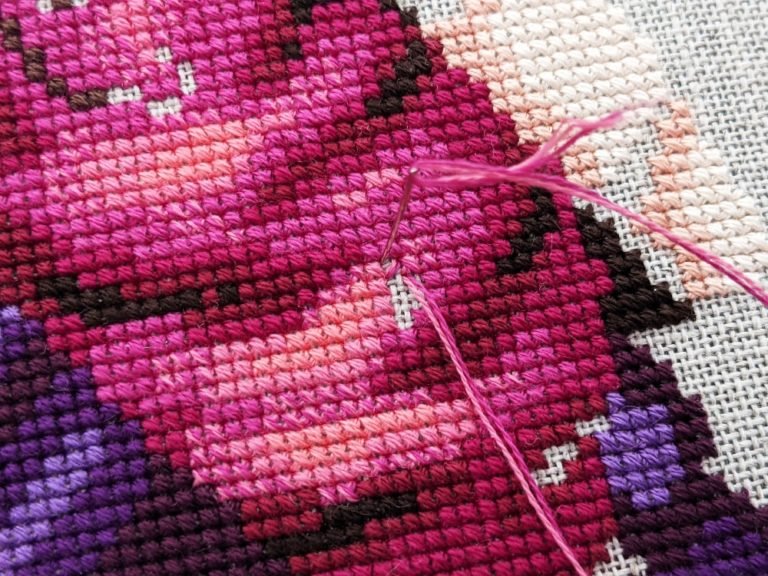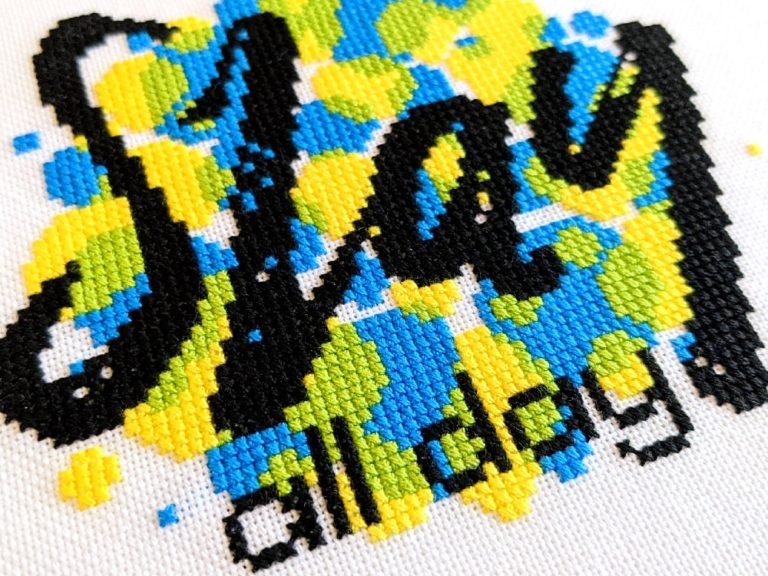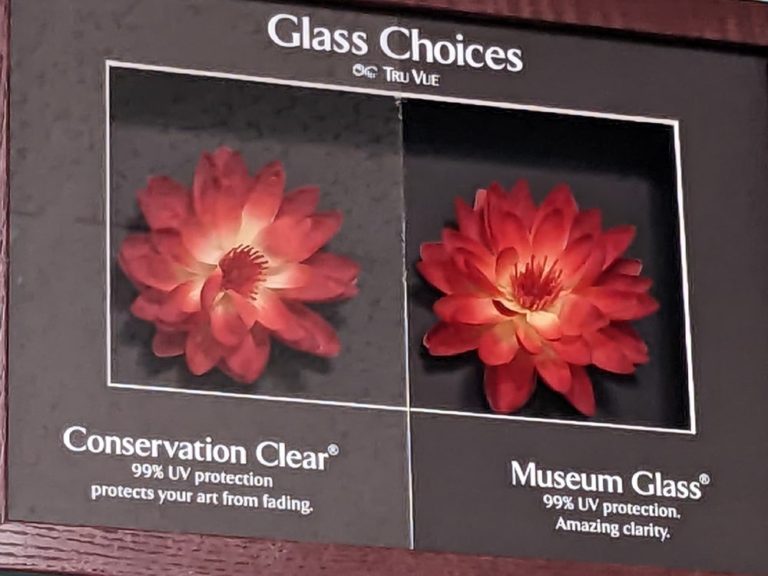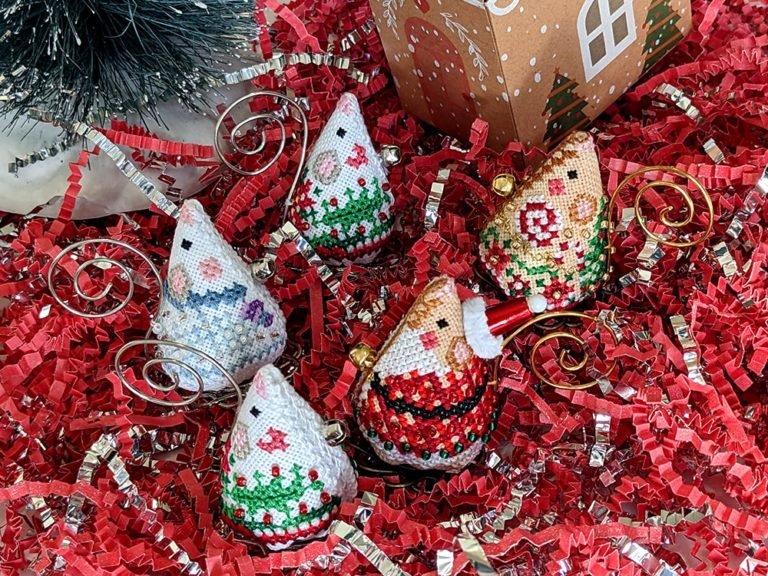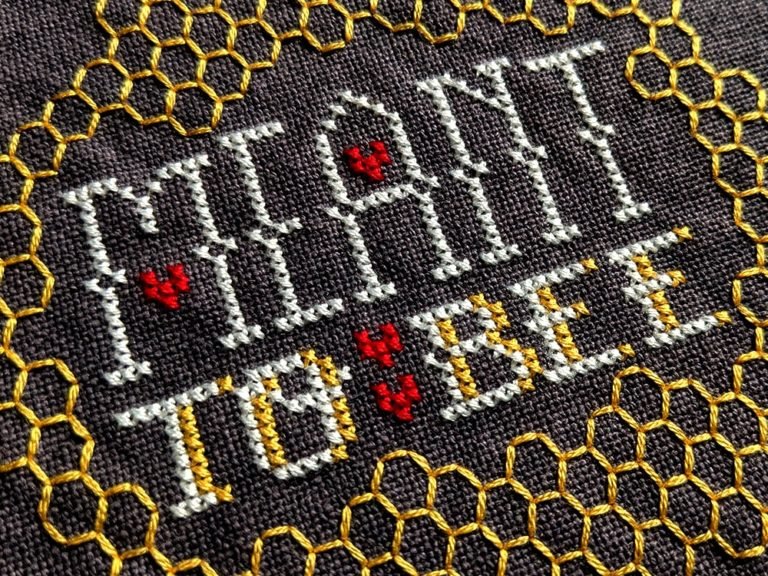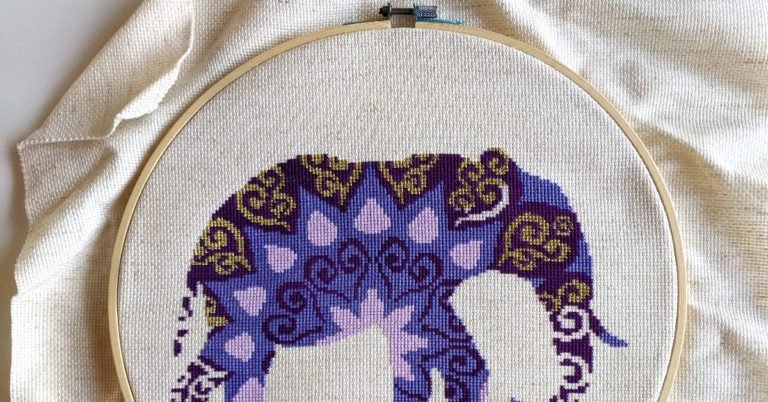What Thread is Used for Cross Stitch?
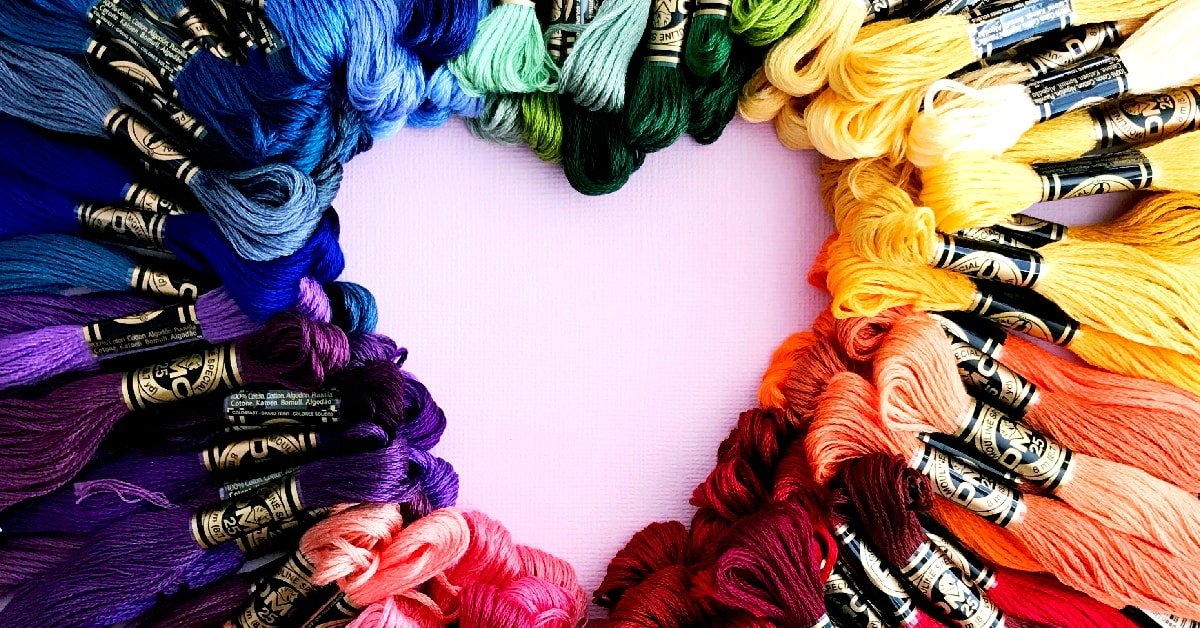
New to cross stitching? No problem!
I’ve seen some confusion around the web about embroidery floss and how to use it.
Typically, stitchers use DMC Six-Strand Embroidery Floss. Each skein can be divided into 6 strands. DMC is the most popular brand of embroidery floss because of it’s obtainability, material, sheen, colorfastness and fade resistance, and huge color selection.
First things first, you DO NOT want to use all 6 strands for cross stitching. Using all 6 strands will cause your project to become bulky, creating uneven tension and warping. If you are doing this, don’t worry. It is a common mistake.
WANT FREE CROSS STITCH PATTERNS?
Sign up for my newsletter to get access.

Why Do Stitchers Use DMC?
- Popularity – You can find DMC at any craft store. They have a long-standing reputation and revolutionized thread with their 6 stranded floss in 1899.
- 100% cotton – Unlike many other off brand flosses that include polyester, your thread won’t melt if it’s ironed. You will want to iron your project when it’s done because it will more than likely get wrinkled during stitching. DMC is also smooth and easy to work with.
- Sheen – Unlike other off brand threads that are dull, this thread develops a beautiful luster during the mercerization process. Other brands try to replicate this by including polyester.
- Colorfast and Fade Resistant – This floss shouldn’t bleed when washed or fade. Although I do not repeatedly wash my finishes, I do like to clean them when they are complete to get rid of hand oils. Check out my tutorial on how I wash my finished projects.
- Color selection – Currently they have 489 solid colors, including 35 new colors introduced in 2017. Whoa! That’s a lot of colors.

Ultimately, DMC produces quality threads which is why they are such a beloved favorite among stitchers.
What Do the DMC Labels Mean?
You’ll notice that there are 2 labels on DMC skeins.
The top label specifies the branding.

This particular skein is part of the Mouline Special DMC 25 line. The brand in this case is DMC.
Mouline Special 25 just means the type of floss. Mouline means that it’s mercerized long-staple cotton. It’s special because it was the first thread divisible into 6 strands. The number 25 is the size of each strand.
The amount of floss in the skein is 8 meters or 8.7 yards.
The back of the label states that the floss is 100% cotton and colorfast.
The bottom label contains the dye lot number, SKU and barcode, color code, and care instructions.
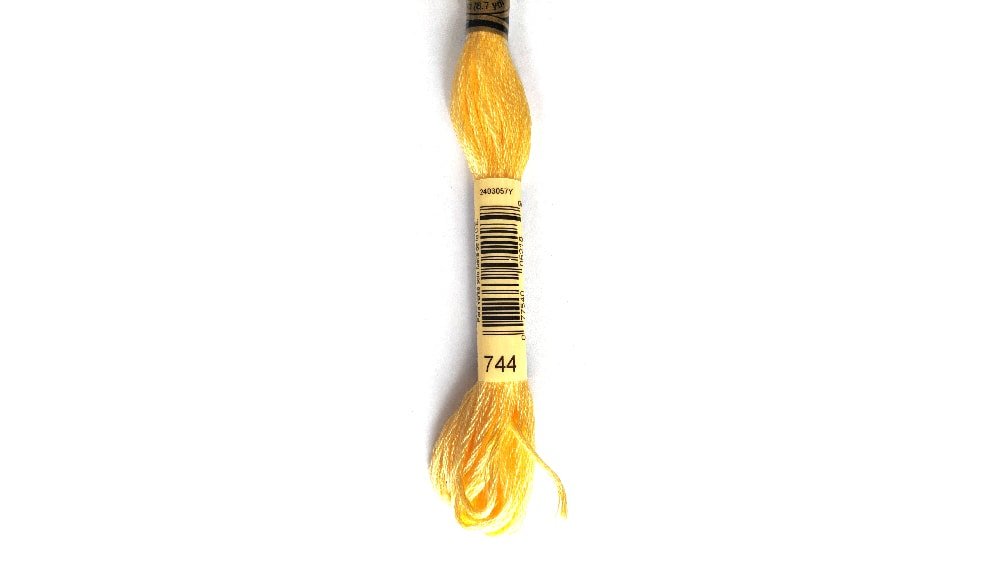
What are Dye Lot Numbers and Why are They Important?
These lot numbers are numbers given to batches of dyed floss. The floss is bulk dyed then cut to the size in each skein.
It is important to buy enough floss in a specific color with the same dye lot for your project.
Purchasing floss with different lot numbers could result in a noticeable difference in color. This will be particularly obvious if you are working on a big section of the same color and one color is slightly off.
Although this is not common, there is still a slight chance. This mostly happens when using older floss then switching to new floss. For example, if you thrift a bunch of floss then run out.
In 1994, DMC changed its color formula for certain colors to abide by environmental standards. The colors affected were 3799, 413, 317, 414, 318, 415, and 762 in the gray family, and 503 and 504 from the blue-green family.
What are Color Codes?
These numbers below the barcode are DMC’s numeric color system. Each color is given a number. These aren’t particularly chronological as DMC has discontinued and added colors over the years.
The most recent additions are colors 1-35.
Most colors you can purchase as a single skein. However, some colors are only available as part of a set.
What Do the Symbols Mean?
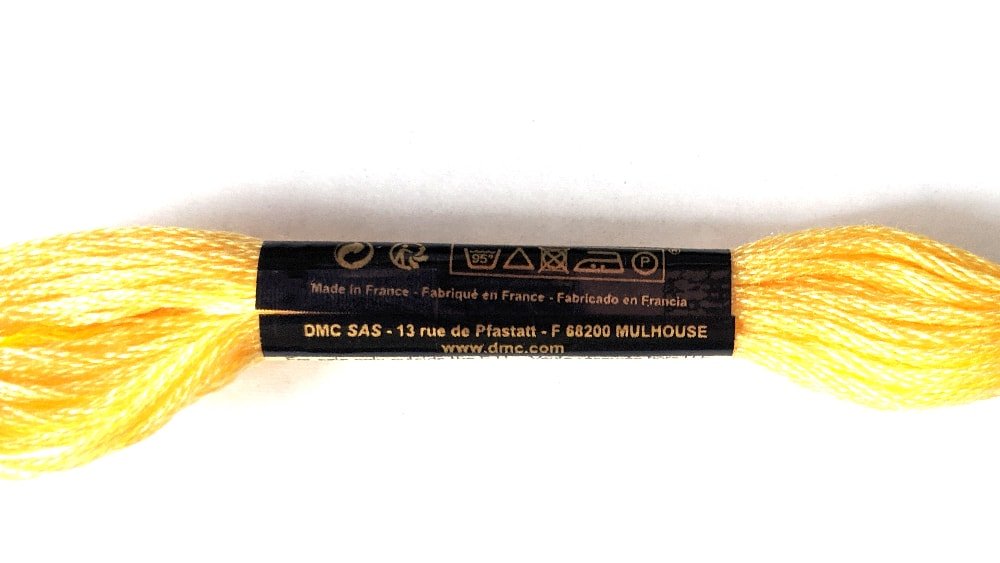
On the back of the bottom label are the care instructions.
The tub means that the floss can be washed in the washing machine up to 95℃ or 200℉.
The triangle means that the floss can be bleached.
The circle in the square with the X through it means that you should not tumble dry.
The iron with the two dots means that you can iron on medium heat up to 150℃ or 300℉.
Lastly, the P in the circle means that you can use any solvent to dry clean except trichloroethylene.
Which End Do You Pull the Floss?
Each skein has two ends that are looped numerous times. One end is under the brand label and the other end sticks out beyond the number label.
Pull from the number end to prevent tangling. This end will allow the floss to easily unravel.
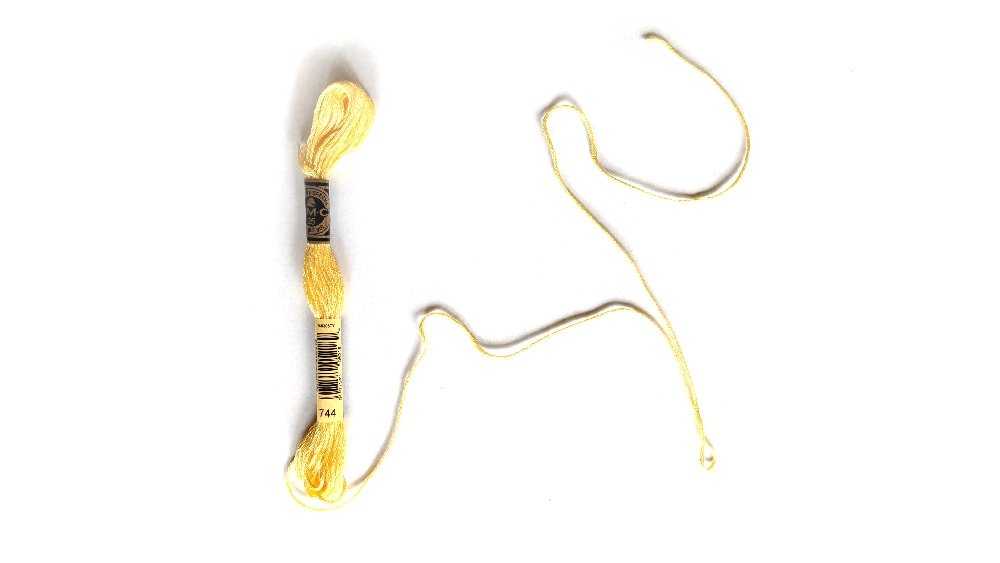
If you pull from the wrong end, the floss will knot and you will have a mess.
How Long Should You Cut Embroidery Floss?
For the most part the length of your working thread is a matter of personal opinion. Some stitchers prefer stitching with longer pieces and some shorter.
Some flosses fray easily while stitching. To prevent this use shorter pieces.
The longer the thread is, the more likely it will tangle and create knots.
A little trick that I learned is to pull the floss out from the number side twice. Once usually isn’t enough floss. This measures about 2 feet.
It is important that the loop you cut on is the same side where it started to prevent confusion. This will keep things consistent so you’ll know which end to pull next time.
There should be 3 crimps created from the looped thread. Because I start with the loop method, I fold my floss in half equating to about a foot of floss.
In my experience, this is enough length to prevent severe fraying and tangles. If I keep running out of floss quickly in a particular section, I will use more floss.
The crimps act as units of measurement to efficiently utilize the length of thread. I have developed a sense of how many stitches I can get out of each length more or less.
If I know I don’t need as much if a particular section, I will cut at one the crimps.
For example, instead of cutting the thread in half for a smaller section, I may want to cut ⅓ and leave ⅔ for a bigger area.
How to Separate the Strands of Floss
Next, we will want to separate the threads now that we have a manageable size of floss. Like I mentioned before, you DO NOT want to use all 6 strands.
The strands are twisted together, but this method is the easiest way that I have learned for preventing tangles. It is also the quickest.
Start to untwist one end and you will notice 6 individual strands. With your fingers hold onto one of the strands.

With your other hand, grab the rest of the strands in your palm and pull down, holding tightly onto the strand that you are pulling out. Don’t use your fingertips to pull down the rest of the strands as they may start to bunch up and knot.
Instead, use your whole hand to work the thread down the strand. It should glide down easily.
Pull 1 strand out at a time. This will help with the neatness of your stitches later. If you pull 2 out at a time, those 2 strands are still twisted together and will twist while you are stitching.
If the floss does become tangles, it just takes a little bit of finessing to separate. Pull the top of the floss back up the single strand and pull the bottom part of the floss down the strand to release the bunching. Keep doing this until the strand comes out smoothly.
How Many Strands are Used for Cross Stitching?
Patterns usually suggest how many strands to use. However, not all patterns do. In most cases, full cross stitches will be done with 2 or 3 strands on 14 count aida or 28 count evenweave/linen.
Usually you will be using 2 strands, but some stitchers prefer to use 3. This is evident on projects where the fabric is a light color and the floss is a dark color. Using 3 strands will help prevent the fabric from showing through.
Another option is to up your thread count to a higher weave such as 16/32 or 18/36.
Personally, I like to use two strands because I like starting with the loop method. My preferred fabric counts are 16 or 32.
You use 1 or 2 strands for backstitching. Some patterns create different line thicknesses by incorporating 1 and 2 strands to look like brushwork.
French knots are usually two strands.
Again, it all comes down to personal preference. Try out different numbers of strands for different techniques and learn what you like best.
Using Cheap Knock-Off Embroidery Thread
I have mostly a whole set of these cheap knock-off threads. I wanted to get lots of stitching done during the pandemic and it was during Stitch Maynia. At the time, Michaels wasn’t allowing curbside pick-up. So I thought I’d give them a try.
The biggest pro is that they are CHEAP! I think it was only about $30 for the whole set and DMC recently raised their prices.
Stitching is one of the cheaper hobbies, but it can still get pretty expensive. Especially because you never seem to have the floss that you need and if there are a lot of colors the cost can add up.
So what’s the problem?
Honestly, I am not a fan of these cheap knock-off flosses. In my opinion, it doesn’t look as good as DMC.
The floss is harder to work with and usually gets tangled really easily for me.
I don’t entirely trust where they come from and how they are made. I am a thread licker and have to think twice about licking this floss to thread my needle.
DMC follows environmental guidelines for their dyeing process and doesn’t use harmful chemicals.
Using Other Embroidery Floss
As you become more advanced, you may want to try other product lines from DMC. They have variegated, metallic, and other threads to experiment with. Again, DMC is just the easiest to obtain if you live by a big box craft store.
In addition, there are hand dyed brands to try such as Classic Colorworks, Weeks Dye Works, and Gentle Art Sampler Threads just to name a few, as well as different materials such as metallics and silks.
These threads will be harder to obtain as you will need to visit your LNS or order online.
Final Thoughts
The biggest mistake I see is using all 6 strands. Experiment with 2 or 3 threads. You will develop a preference. I like using 2 threads. For me, 3 threads was slightly too bulky. If you want more coverage, use a smaller fabric count.
Don’t cut your floss too long otherwise it will shred and tear. Pull enough thread from the skein to finish the area, but not too much that it will tangle and create knots.
Try variegated flosses once you become more experienced. These flosses should be stitched one stitch at a time to create the full effect.
Happy Stitching!


